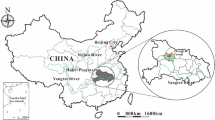Abstract
Tunnel engineering is affected by a variety of factors, which results in large detection errors in tunnel engineering. In order to improve the monitoring effect of tunnel engineering, based on BPNN and MARS machine learning regression algorithm, this research constructs a tunnel engineering monitoring and prediction model. Moreover, the gray residual BP neural network designed in this study uses a series combination, and the residuals obtained from the gray model are used as the input data of the BP neural network, and the output of the combined model is used as the prediction result. By applying the monitoring data of the convergence of the upper surrounding of the tunnel surface section and deformation of the arch subsidence, it is verified that the proposed method based on the combined model of BPNN and MASR can predict and analyze the tunnel deformation monitoring data very well.














Similar content being viewed by others
References
Junyu LL (2010) Application remote video monitor system in cross-river tunnel engineering. Shanghai Construct Sci Technol 3:16
Xie X, Feng L (2011) Development of wireless sensor network technology and its challenges in subway tunnel engineering. Yanshilixue Yu Gongcheng Xuebao/Chin J Rock Mech Eng 30(66):4047–4055
Wang F, Zhao Y, Li C et al (2018) An experimental study on the corrosion characteristics of the karst tunnel engineering area in Southwest China. Bull Eng Geol Environ 78:4047–4061
Bui HG, Meschke G, Schillinger D (2018) Application of the finite cell method to tunnel engineering simulation. PAMM 18(1):e201800011
Zhong Y (2018) Technical innovation for Sanyang road cross-river tunnel project. Front Eng Manag 5(3):411–415
Hu XD, Deng SJ, Wang Y (2018) Mechanical tests on bearing capacity of steel pipe-frozen soil composite structure applied in Gongbei Tunnel. Yantu Gongcheng Xuebao/Chin J Geotech Eng 40(8):1481–1490
Dingli Z, Zhenyu S (2018) Structural stability of complex tunnel surrounding rock and its control. J Hydroelectr Eng 37(2):1–11 (in Chinese)
Mori T, Iizuka S, Nakayama T (2017) Material engineering for silicon tunnel field-effect transistors: isoelectronic trap technology. MRS Commun 7(3):1–10
Umili G, Bonetto S, Ferrero AM (2018) An integrated multiscale approach for characterization of rock masses subjected to tunnel excavation. J Mech Geotech Eng 10(3):513–522
Zhang H (2018) The longest railway tunnel in China. Engineering 4(2):165–166
Boultbee N (2018) Upper Lillooet river hydroelectric project: the challenges of constructing a power tunnel for run-of-river hydro projects in mountainous British Columbia. Engineering 4(2):260–266
Vignais N, Weresch J, Keir PJ (2017) Posture and loading in the pathomechanics of carpal tunnel syndrome: a review. Crit Rev Biomed Eng 44(5):397–410
Li Y, Wang Z (2017) Wind tunnel experiment on polypeptide derivatives in controlling wind erosion. Nongye Gongcheng Xuebao/Trans Chin Soc Agric Eng 33(5):149–155
Zhang N, Fang Q, Li Y et al (2017) Mechanical analysis of secondary lining of high-speed railway tunnel. KSCE J Civ Eng 22(5–6):2384–2389
Joshi A, Kiran R, Sah AN (2017) An experimental analysis to monitor and manage stress among engineering students using Galvanic Skin Response meter. Work 56(3):1–12
Yan S, Yan X (2019) Using labeled autoencoder to supervise neural network combined with k-nearest neighbor for visual industrial process monitoring. Ind Eng Chem Res 58(23):9952–9958
Gong JF, Zhu Y, Zhang GZ (2018) The grade discrimination of large deformation of layered surrounding rock in tunnel and its treatment countermeasures. J Railw Eng Soc 35(12):51–55
Shi YM, Gao FP (2017) Lateral instability and tunnel erosion of a submarine pipeline: competition mechanism. Bull Eng Geol Environ 1:1–12
Huang M, Zhang Z, Tan Z (2017) Construction model of deep tunnel for urban flood control and drainage in China. Tumu Gongcheng Xuebao/China Civ Eng J 50:76–81
Wang HT, Zhuang XX, Sun HY (2019) Prediction of pipeline displacement induced by water leakage during tunnel construction. Geotech Geol Eng 37:5383–5389
Vassallo R, Mishra M, Santarsiero G et al (2019) Modeling of landslide–tunnel interaction: the Varco d’Izzo case study. Geotech Geol Eng 37:5507–5531
Wang X, Cai M (2020) A DFN–DEM multi-scale modeling approach for simulating tunnel excavation response in jointed rock masses. Rock Mech Rock Eng 53:1053–1077
Liu T, Gong GF, Yang HY et al (2019) Trajectory control of tunnel boring machine based on adaptive rectification trajectory planning and multi-cylinders coordinated control. Int J Precis Eng Manuf 20(6):1721–1733
Gong YF, Wang B, Wei HB et al (2018) Surface subsidence law of double-line shield tunnel based on Peck formula. Jilin Daxue Xuebao (Gongxueban)/J Jilin Univ Eng Technol Ed 48(5):1411–1417
Acknowledgements
The research is funded by the National Natural Science Foundation of China (NSFC) under Grant No. 41790434 and the Key Research and Development Program of China Railway (Grant No. K2019G033).
Author information
Authors and Affiliations
Corresponding author
Ethics declarations
Conflict of interest
The authors declare that they have no conflict of interest.
Additional information
Publisher's Note
Springer Nature remains neutral with regard to jurisdictional claims in published maps and institutional affiliations.
Rights and permissions
About this article
Cite this article
Fei, J., Wu, Z., Sun, X. et al. Research on tunnel engineering monitoring technology based on BPNN neural network and MARS machine learning regression algorithm. Neural Comput & Applic 33, 239–255 (2021). https://doi.org/10.1007/s00521-020-04988-3
Received:
Accepted:
Published:
Issue Date:
DOI: https://doi.org/10.1007/s00521-020-04988-3




